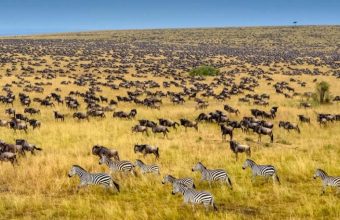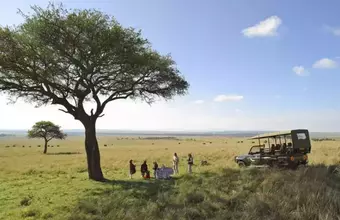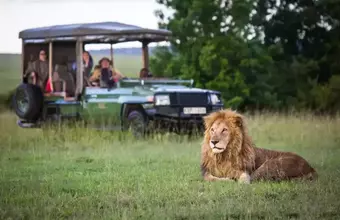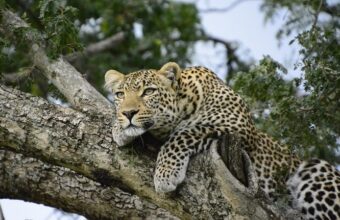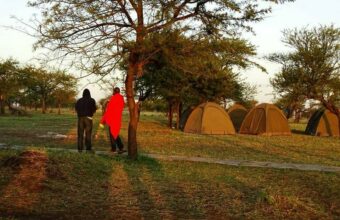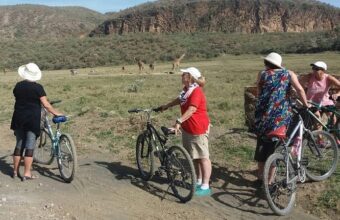The best time to visit Kenya for safari
When to go on safari in Kenya
The best time to go on safari in Kenya: Quick reference
In my experience, the best times to go on safari in Kenya are the two "shoulder seasons" in June and later in September-October.
June is perhaps my overall favourite month. Everything is green after the rains, it's nice and cool with far fewer tourists than the July peak season, and the first migrant wildebeest might start to arrive from the Serengeti into the Masai Mara.
Likewise, during September-October the crowds are starting to thin out, the migrating herds should hang around until about the middle of the month and there are good opportunities to watch them cross the Mara River. Wildlife viewing in all the other parks is also excellent and on the coast the sea is calm and perfect for snorkelling and diving. Temperatures are idyllic.
On the other hand, the worst month for safari in Kenya is probably April: the height of the wet season, with many camps closed and roads washed away.
Overall best months: June & September-October
High season: July-September & Christmas-February
Low season: March-April & November
Best weather: February & September
Worst weather: April
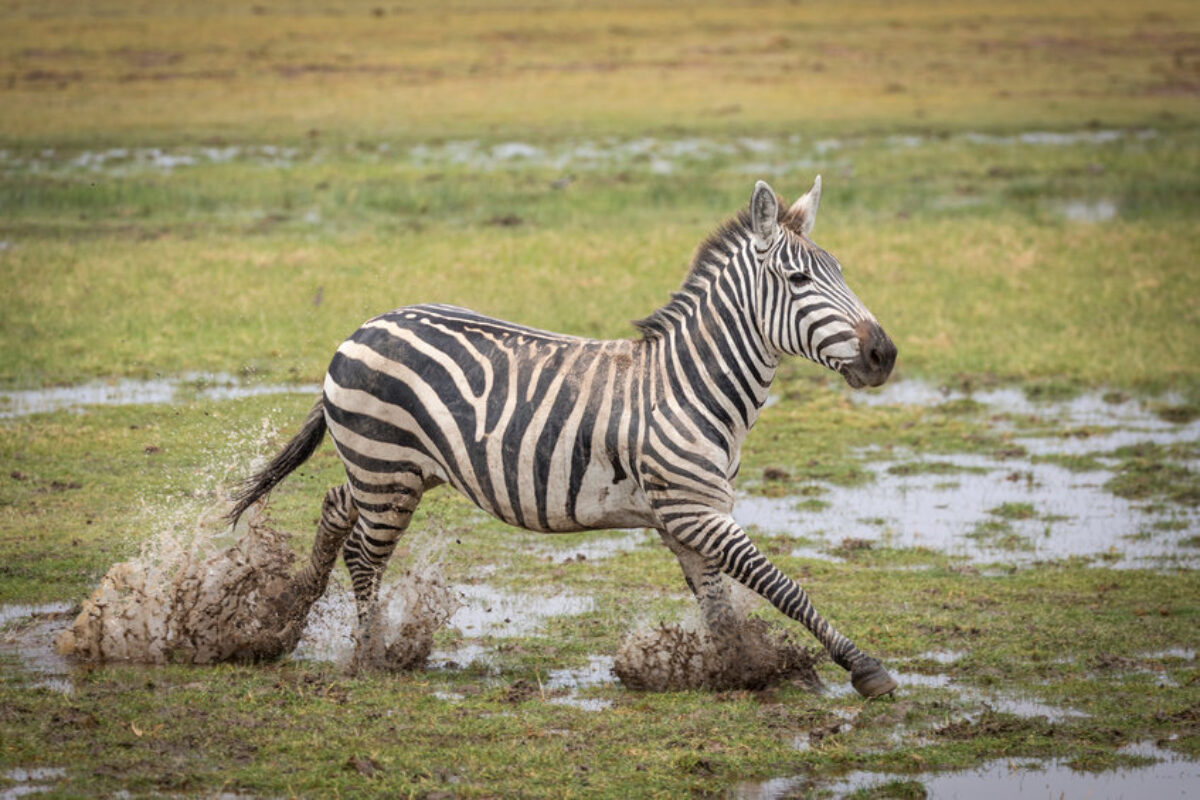
A zebra trudges through the rains Amboseli National Park
The best time for safari in Kenya
Safari in Kenya month to month
January & February
This is a hot and dry period. Animals gather around water holes and river banks which makes for a good period to be on safari. Many migratory birds are present. On Kenya’s coast, water clarity is at its best between January and February. A busy time for tourism, especially the start of January.
March
The start of the long rainy season and generally a bad time to go on safari. But, with few other visitors and lower prices if the rains are late arriving then this can be a good period.
April
The height of the wet season. Many safari camps close and roads can be washed away in flash floods. A bad time to be in Kenya.
May
The first part of May is similar to April, but by the tail end of the month things should be starting to dry out. The landscape will be lovely and green and although the safari camps will be starting to re-open, prices remain low. If you’re lucky with the weather then late May can be a lovely time to visit.
June
A superb time to be in Kenya. Everything is nice and green, the high season crowds are yet to arrive, the temperatures are pleasantly warm (but note that it can be miserable on the coast) and the wildebeest will be starting to mass on the Kenya-Tanzania border which makes for some exciting river crossing spectacles.
Although best known for the wildebeest migration, June is also the beginning of the humpback whale migration. Head to the Watamu Marine National Park to see whales — and dolphins — on boat tours between June and August.
July
Generally dry throughout the country with spectacular wildlife viewing in the parks and reserves. Wildebeest flood the plains of the Mara. The coast is now hot and dry. But this is also a busy and expensive time to visit.
August & September
A repeat of July, but by September there is a slight tail off in visitor numbers as school holidays end.
October
A superb time to visit. The wildebeest should hang around until about the middle of the month and there are good opportunities to watch them cross the Mara River. Wildlife viewing in all the other parks is also excellent and on the coast the sea is calm and perfect for snorkelling and diving. Temperatures are idyllic.
November
Safari prices start to drop as tourists head home and the short rains fall. Even so, this isn’t a bad time to be in the country as the rains are rarely strong enough to totally disrupt your travels. Migratory birds start to arrive.
December
The country is nice and green after the short rains and there are birds everywhere. The Christmas period is a busy tourist season but if you can come before that then you’ll benefit from lower prices and a tranquil safari.
Kenya climate by region
There are two things that define Kenyan weather: altitude and the monsoons. With the equator running straight through the middle of Kenya you might expect the country to be relentlessly hot. But it’s not as simple as that. Kenya is rippled in high mountains and plateaus and so altitude plays an immensely important role in Kenyan weather patterns.
In fact, it’s possible to stand in searing 40 degree heat in the northern deserts and snap a photograph of the snow and ice covering the summit of Mt Kenya!
The coastal strip is low-lying and has a hot and humid tropical climate year round (although things do cool down quite considerably between June-August). The vast northern deserts and semi-deserts (where parks such as Samburu are located) are always hot – sometimes too hot for comfort. Rain is also rare throughout the north.
The central and western parts of the country are much cooler, wetter and greener and for this reason this is where the majority of Kenyans live. The climate in Nairobi and other highland areas is one of almost eternal spring, and nights can get quite chilly.
This area is home to the Laikipia area conservancies, the Aberdares National Park and Nairobi National park among others. In the far west of the country, around Lake Victoria, the altitude is a little lower and it can be hot and humid with frequent rainfall.
In between the low and high altitude extremes is the Rift Valley. Fairly low lying and prone to drought, this is where some of the most famous national parks and wildlife conservancies (such as Tsavo and Amboseli) are located. It can be very hot here in the middle of the day but cool enough to need a fleece at night. The Masai Mara National Reserve is a bit higher and wetter and while days in the Mara are often idyllic it can be damn right cold on an early morning safari.
Kenya’s rainfall and monsoons
Aside from temperature the big thing that will impact when you visit Kenya and where you go is the rainfall.
Kenya receives two monsoon rains a year. The long rainy season runs from around March to May and the short rainy season provides the wet stuff between about late-October and mid-December.
During the long rainy season you can expect rain throughout the country on a near daily basis. Rivers can burst their banks and roads can get washed away. Most of the time the rain falls in the afternoon, but it sometimes rains all day. Nairobi can have what feels like endless days of grey, dreary drizzle. Throughout the country, even when it’s not raining it can be very cloudy. In general this is not the best time to visit Kenya.
The short rains are less predictable and may fail to materialise at all. However, as with the long rains, the rain mostly falls in the afternoon and not always everyday. There can be pleasant sunny periods in between the rain showers.
With changing climatic patterns these monsoon periods have become much less defined and in recent years there have been droughts when it should have been raining and floods when it should be bone dry.
Even though it’s not technically a wet season, the period between June and September still sees regular rainfall over large parts of the country, in particular the highland areas, the west and the Masai Mara. Temperatures are neither too hot nor too cold and everything is lovely and green. On top of that this is also when the wildebeest migration rolls through the Masai Mara. Overall this is a great time to go on safari in Kenya.
The driest and hottest time of year is January to March. On the coast and at lower altitudes it can be overwhelmingly hot. At this time of year the vegetation in many areas is dry and sunburnt but it’s a good time to be on safari – especially in a park such as Samburu or Tsavo when animals are drawn to the remaining water sources.
One of the biggest surprises visitors to Kenya get is how chilly it can get on a safari, especially those at higher altitudes such as the Maasai Mara and Laikipia where nighttime temperatures can fall below 10C. Factor in the windchill when zipping along in an open jeep at dawn and the reality is that safari-goers can become quite cold. Pack layers and be prepared.
Green, ‘shoulder’ & peak seasons
When booking a Kenyan safari you’ll likely hear the terms green season, shoulder season and peak season bandied about. But what do they all mean?
Peak season means high tourism season (July-September/October and Christmas to late February). Naturally enough this corresponds with the best times to be in Kenya, but it also means lots of other tourists, booked out lodges and high prices.
Shoulder season (roughly late-May, June and October) is the in-between time of year. For reasons of weather or wildlife sightings, the shoulder season is considered not quite as good as high season but much better than low season. There are fewer tourists and lower prices than in high season. A little secret: the advantages of travelling to Kenya in the shoulder season outweigh the negatives, and this is perhaps the best time to travel here (except for on the coast, which can be unexpectedly cold and wet).
The term ‘green season’ was perhaps coined to make potential visitors think of lush green landscapes. In reality though it means low season and it covers the months of mid-March to early May and November to early December. Kenya will be looking beautifully green at this time, but that’s because it rains – and at times it rains a lot!
Many safari camps are closed and getting around can be hard. This is generally a bad time to visit Kenya. On the plus side there are few other visitors and safari prices are as low as they get. Northern parks such as Samburu, Buffalo Springs and Shaba can actually be quite rewarding at this time.
Festivals and holidays
Kenya generally observes a Christian calendar so major celebrations and holidays such as Christmas and Easter are observed countrywide. Muslim holidays such as Eid ul Fitr will be observed in most coastal and north eastern areas. Only the holy Islamic month of Ramadan will have an effect on your travels — during this time, you might find stores and hotels closed during daylight hours and at sunset for the breaking of the fast.
There are fewer music and cultural festivals than you might expect, but for a chilled out festival, try the Lamu Yoga Festival in February — five days of yoga in stress-free, car-free Shela, Lamu. Various styles of yoga are taught by instructors from all over the world and are combined with celebrations of Swahili culture such as sunset dhow cruises.
The Kenya Music Festival is held over ten days in August in Nairobi. It draws big name African and international acts.
The end of the year brings the Rusinga Cultural Festival — an extravaganza of colour, music, dance and sport to celebrate and preserve the culture of the AbaSuba people of Uganda and Kenya. Held on the last Thursday and Friday before Christmas on the islands of Rusinga, the celebrations address various social and cultural issues. The headlining event is the boat races in wooden canoes where both men and women row along the lake in clouds of song and dance — not to be missed!
When to go FAQs
Your questions, our expert answers
Question
Is February a good time to visit the Masai Mara, or would June-July be better? What would be the differences?
Answer
February is a very good time for safari in the Masai Mara, but also very different to the experience in June and July.
It's hotter and drier in February and generally there are fewer other tourists. There will still be plenty of zebra and wildebeest around but these are the non-migrating resident herds, so they don't form the massive iconic herds that you might see on TV.
July is good because the migrant wildebeest are all normally in the Mara by then, but its also absolute peak high season so can be busy and expensive. June is perhaps my overall favourite month. Everything is green after the rains and it's nice and cool with far fewer tourists than July, but the first migrant wildebeest might start to arrive (it all depends on rains and the state of the grass).
In short, all three months are excellent but each is different so it might be best to go with whatever just suits your timings better.
Question
I will be in Kenya in early March and am looking for a five day safari for wildlife photography and birdwatching. Where would you recommend for me noting it is the start of the rainy season?
Answer
Early March is still a bit early for the rainy season so you might just get the odd thunderstorm. If birds are your real interest and you only have five days then probably the easiest is to go down to the Masai Mara via the Rift Valley lakes of Naivasha and Elementia or Nakuru. This would give you a good range of avian habitats and species in a short space of time. Don't forget as well that Nairobi itself has some excellent birding in the various forests and parklands in and around the city. Plus of course, there's the superb Nairobi National Park where you will see a lot of wildlife and birds.

